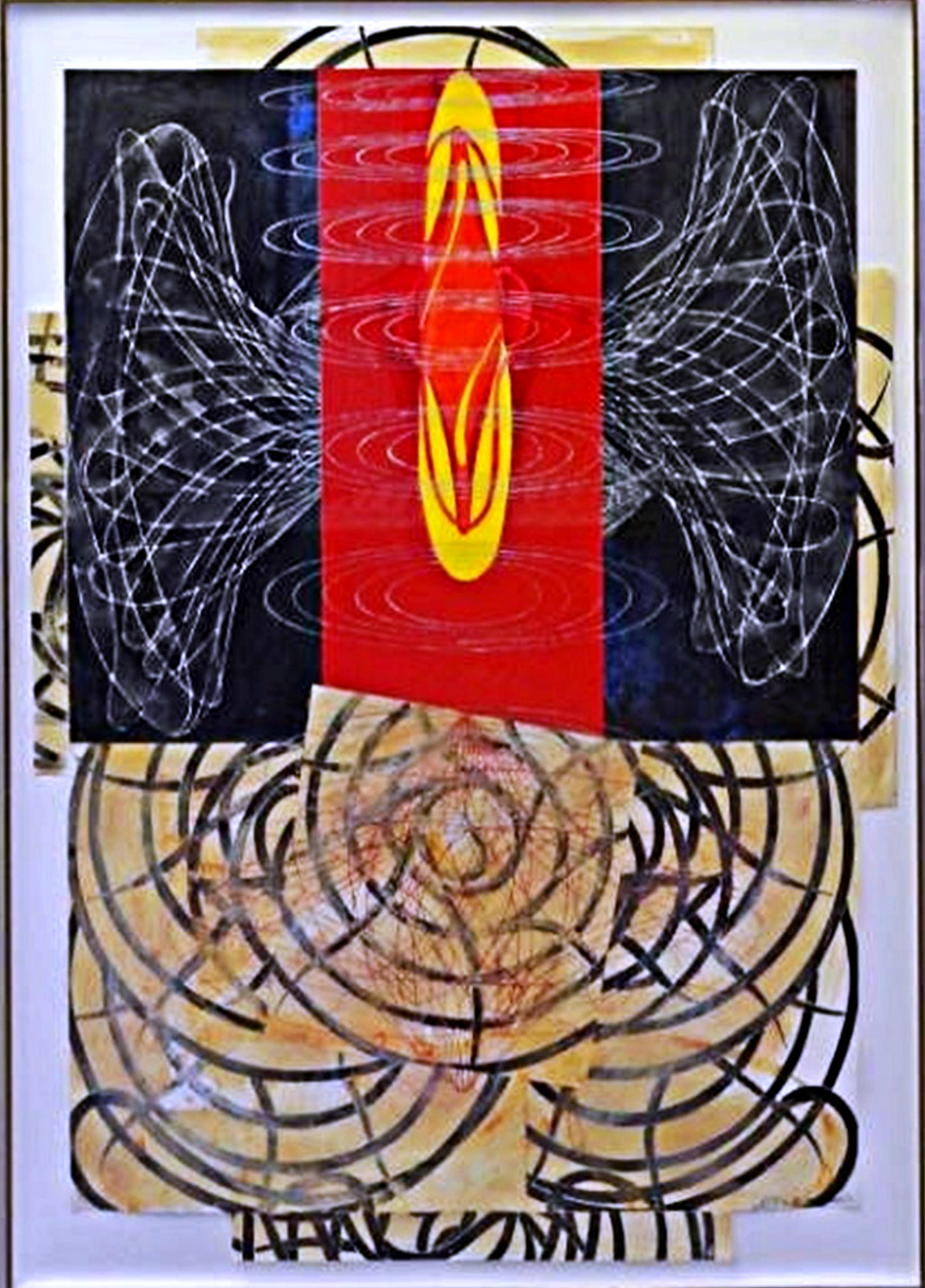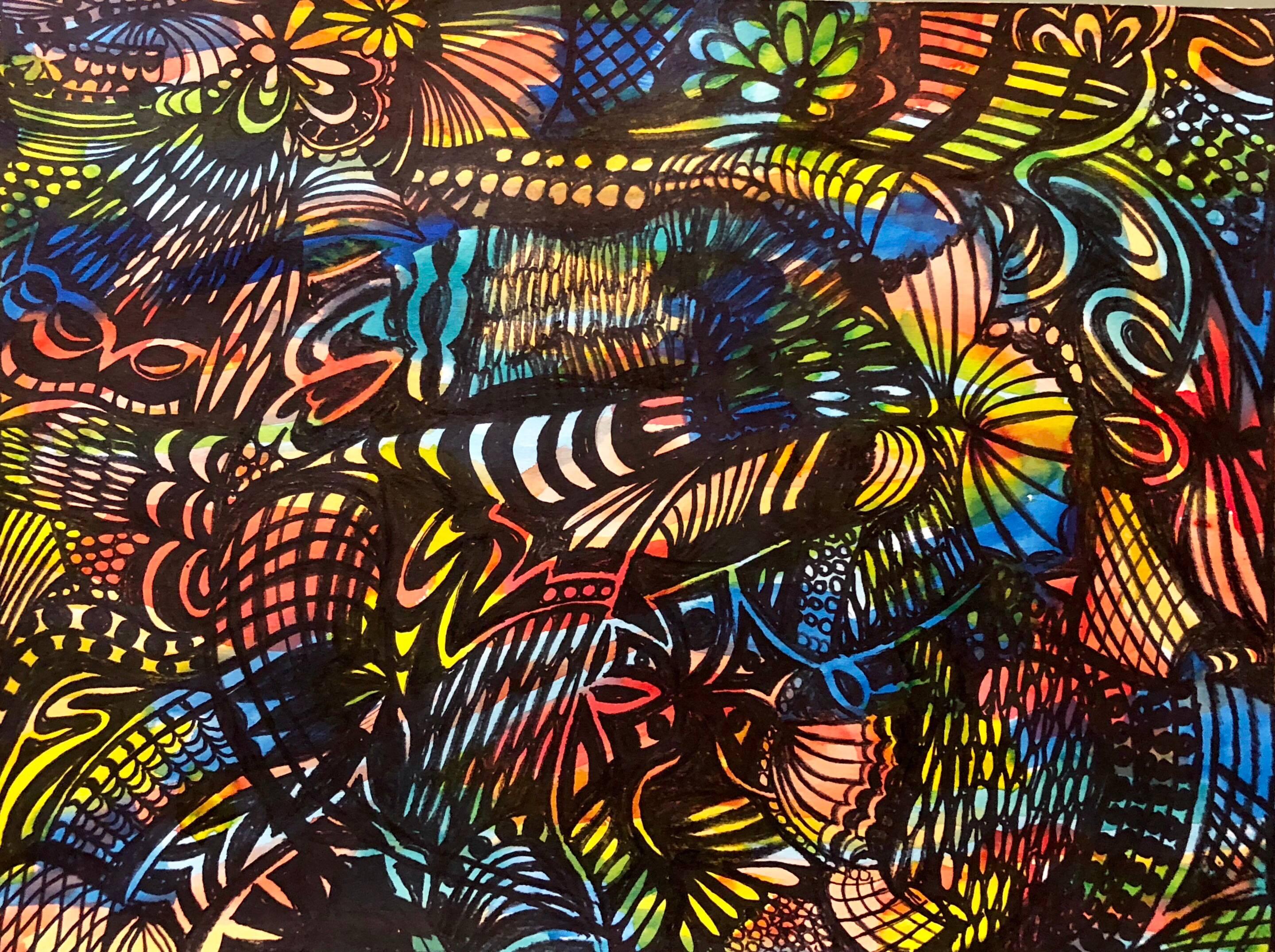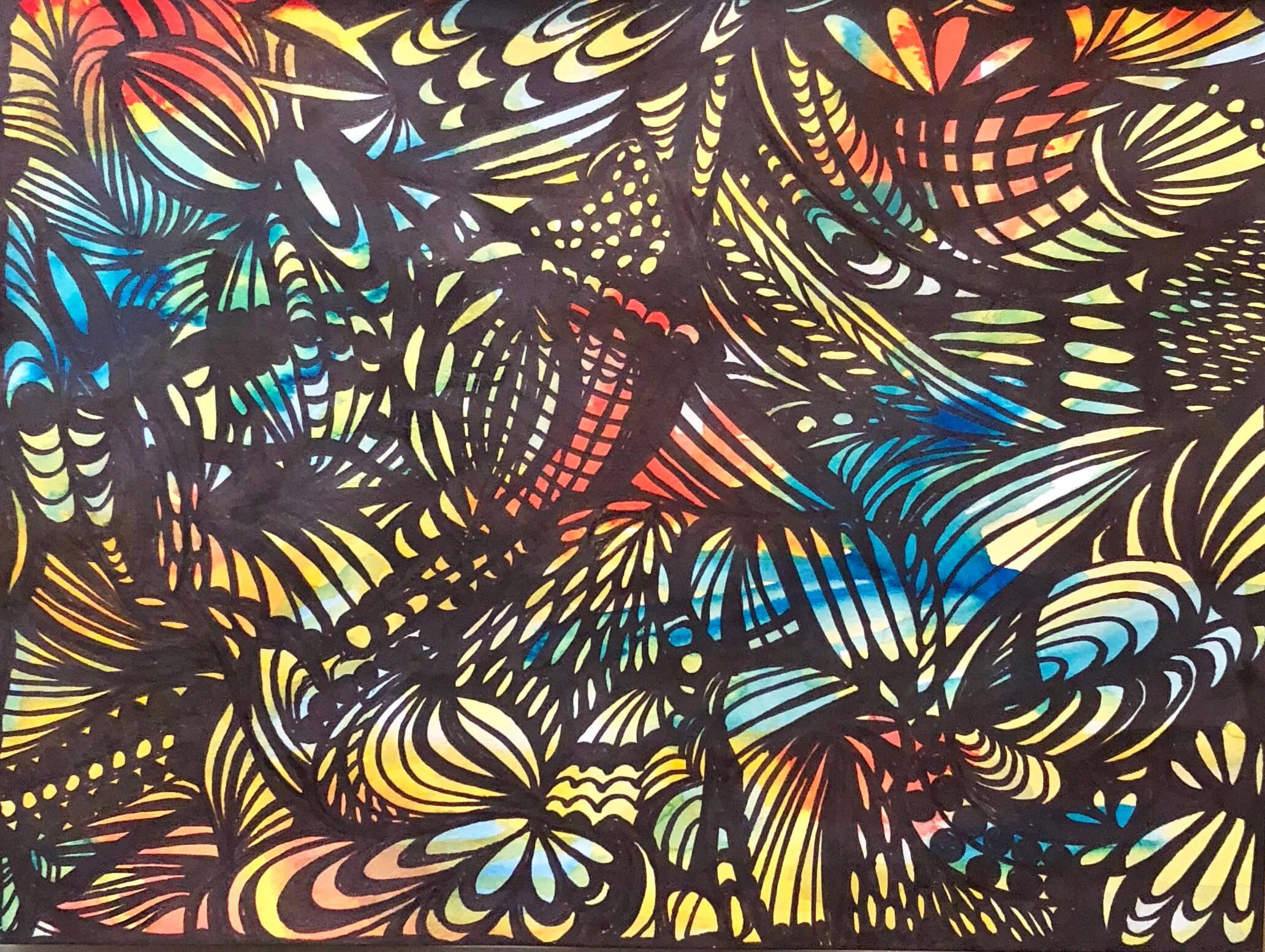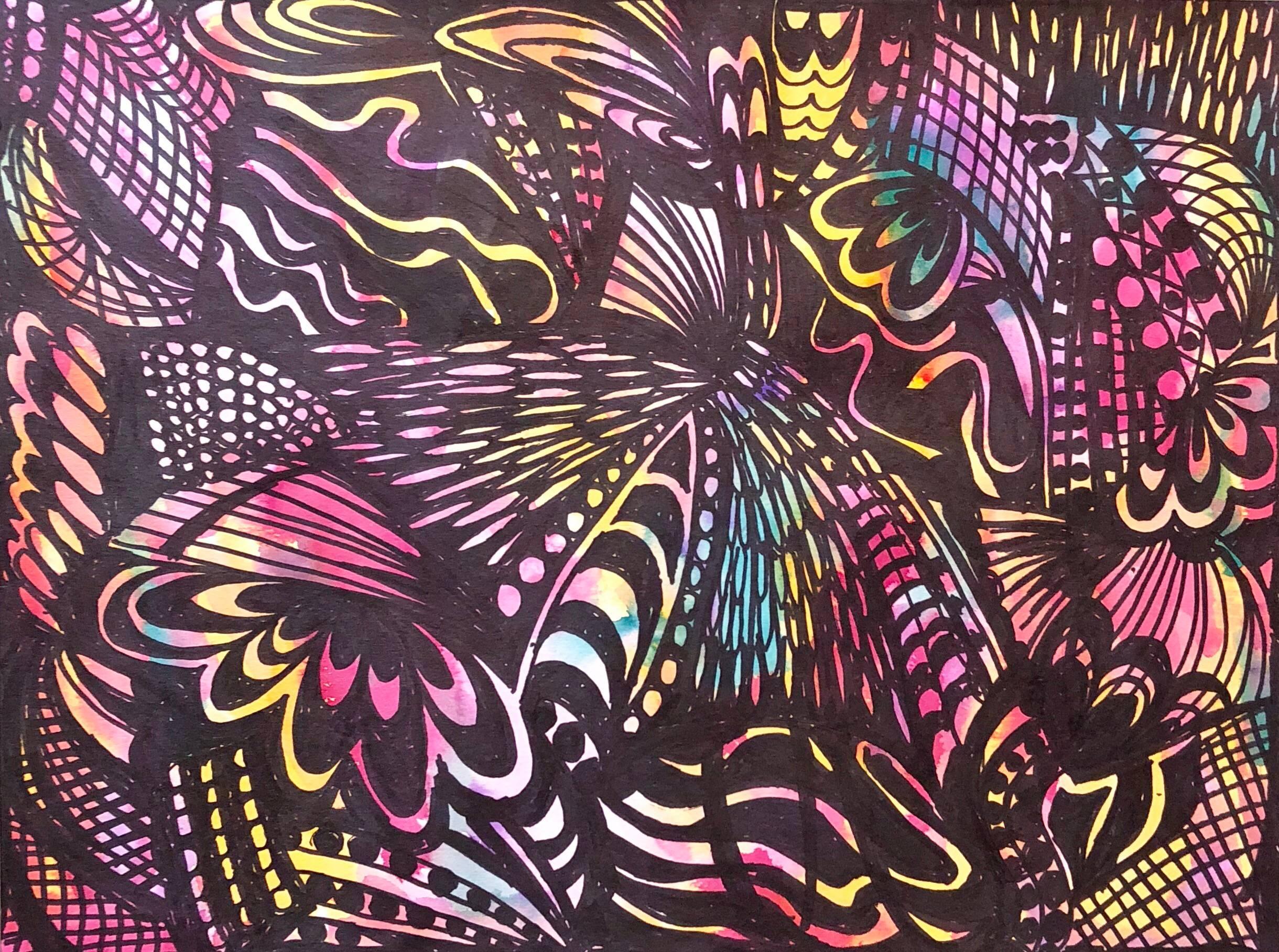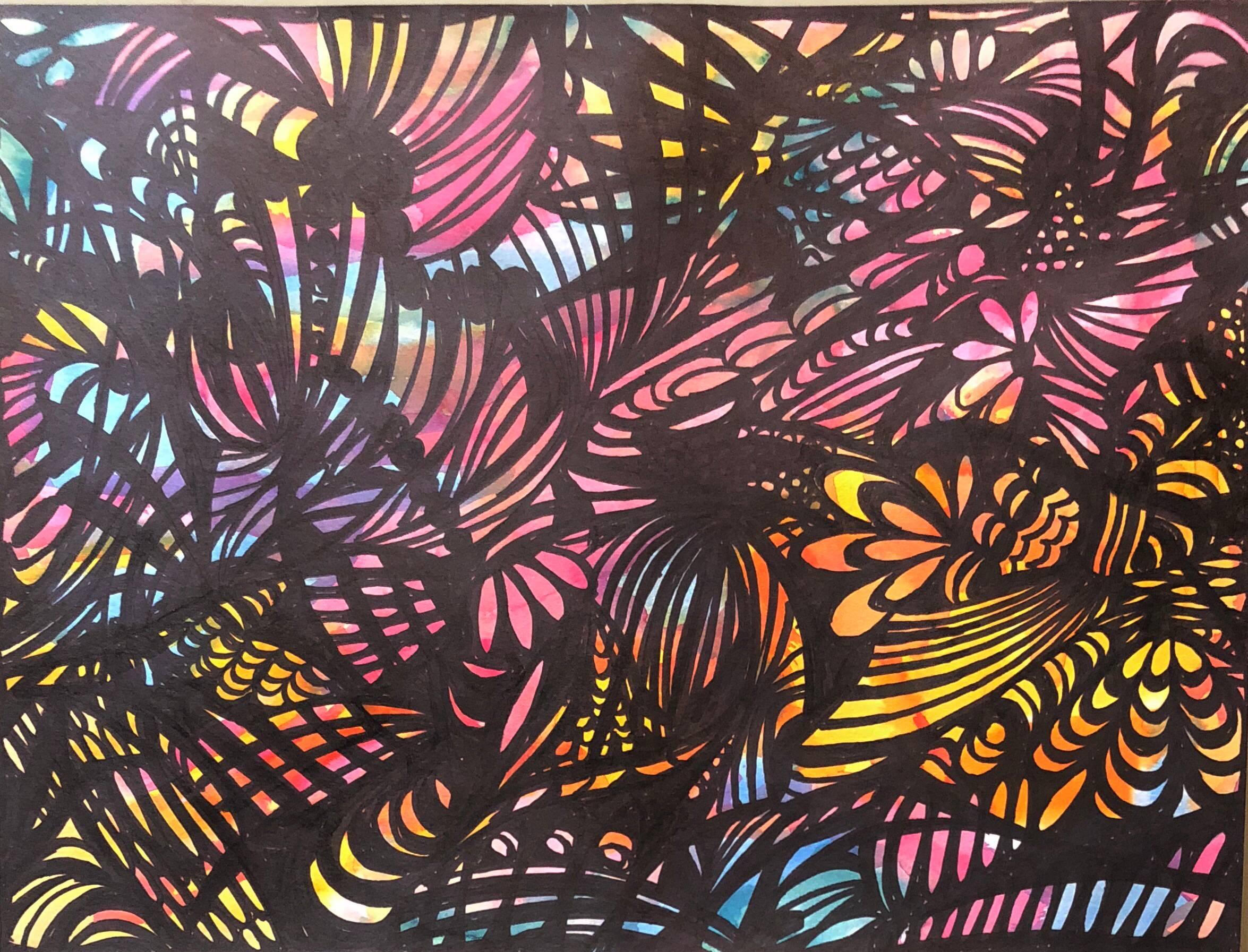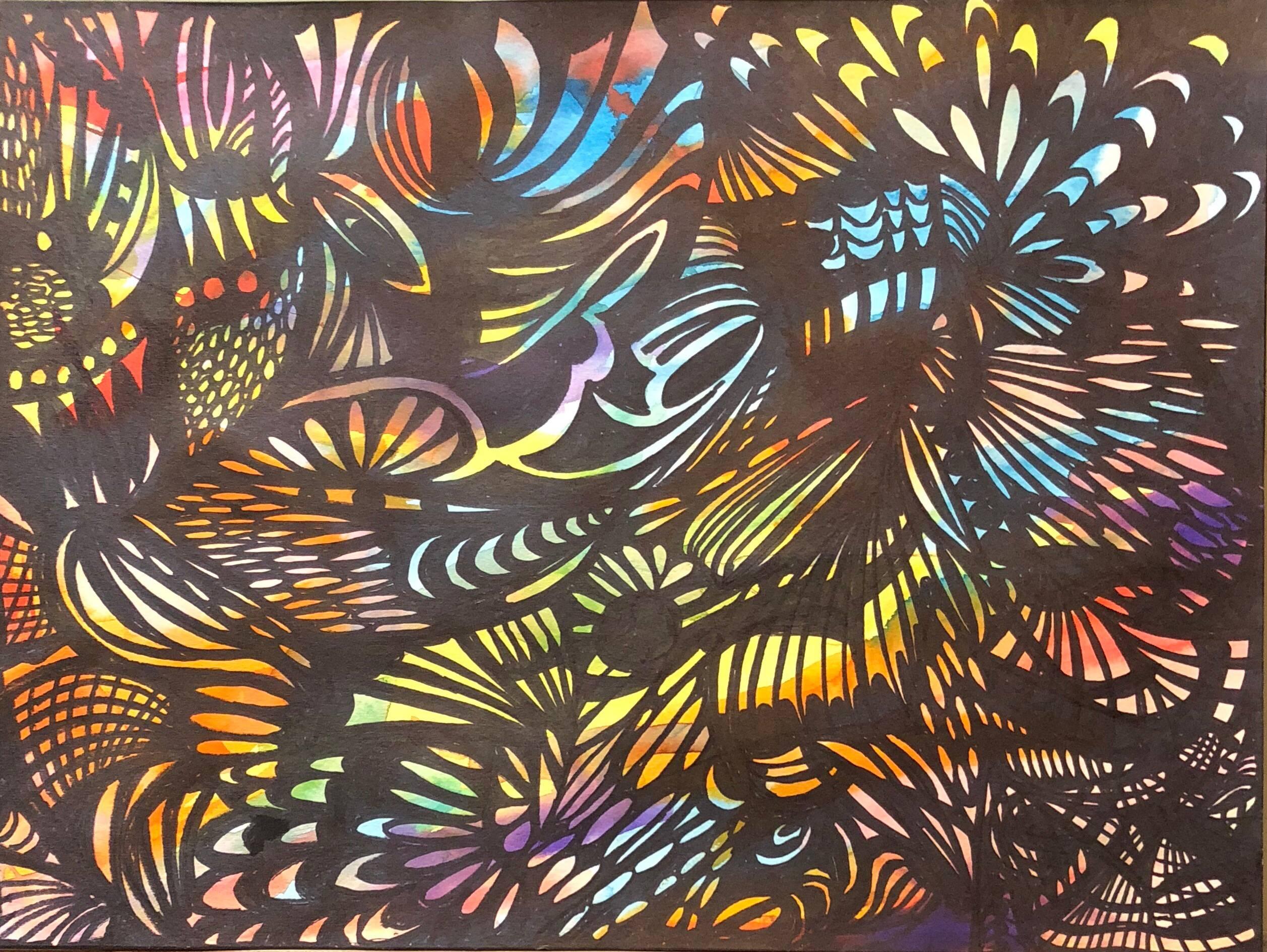Items Similar to 'Pointillist Abstract', Paris, Étretat, New York, Whitney Museum, MoMA, PAFA
Want more images or videos?
Request additional images or videos from the seller
1 of 15
Manfred Schwartz'Pointillist Abstract', Paris, Étretat, New York, Whitney Museum, MoMA, PAFACirca 1960
Circa 1960
About the Item
Estate stamp, verso, for Manfred Schwartz (American, 1909-1970) and painted circa 1960.
Paper dimensions: 15 x 19.75 inches.
Born in Lodz, Poland, Manfred Schwartz immigrated to America in 1920 and first studied at the Art Student's League of New York, the Cape Cod School of Art and the National Academy of Design. In 1929, he moved to Paris where he continued his studies at the Sorbonne and the Académie de La Grande Chaumière. While in Paris, Schwartz became active in the School of Paris and exhibited with success including with Lilienfeld and Durand-Ruel Galleries (1947, 1949, 1950). He also had early success in the United States, exhibiting widely with the Society of Independent Artists (1931), the Pennsylvania Academy of Fine Arts (1940-1942, 1951, 1968 medal), Art Institute of Chicago (1942, 1944), Whitney Museum of American Art (1942-1963) and New York's Museum of Modern Art. Schwartz was a charter member of the Federation of Modern Painters and Sculptors, a member of the Société des Artistes Indépendants Américains et de la Société des Artistes Indépendants de Paris and was the recipient of the Silvermine Guild Award (1965), the Marine Award (1967) and a Gold Medal at the Pennsylvania Academy of Fine Arts (1968).
Prominent in the rapidly changing New York art scene of the middle decades of the 20th century, Schwartz's career was firmly intertwined with the major developments and figures of American modernism. His earliest teachers, John Sloan and Charles Hawthorne, were leaders of the Ashcan School. Early in his career, Schwartz exhibited with Maurice Vlaminck, Bernard Buffet, Edward Hopper, and Andrew Wyeth. Among his inner circle of artists were Marcel Duchamp and Roberto Matta. In the 1930s, Schwartz also owned and directed his own New York gallery. Manfred Schwartz's work has been the subject of two retrospective one-man exhibitions at the Whitney Museum of American Art and the Brooklyn Museum of Art.
In 1950, at the suggestion of Henri Matisse, Schwartz visited Étretat on the Normandy coast which inspired the development of his, later, pointillist style Unlike previous visitors including Courbet, Monet and Matisse, Schwartz looked down instead of up at the imposing cliffs and discovered a universe of shifting color and light in the beach. A second visit to Étretat, in 1960, culminated in his exclusive adoption of Pointillism, the style so elegantly on display in the present work. Manfred Schwartz's work is held in the permanent collections of the Guggenheim Museum, the Museum of Modern Art, the Metropolitan Museum of Art, the Brooklyn Museum, the Philadelphia Museum of Art among others.
"Only a confident colorist could have achieved such a rich painterly surface . . . . Without repudiating the impressionist heritage, Schwartz conferred on both his method and his subject a vision wholly his own--and wholly contemporary." Hilton Kramer, New York Times, 1971.
This work is accompanied by a 1st Edition copy of 'Étretat: An Artist's Theme and Development' by Manfred Schwartz, published by Shorewood Publishing (1965).
Reference:
E. Benezit, Dictionnaire des Peintres, Sculpteurs, Dessinateurs, et Graveurs, Jacques Busse, 1999 Nouvelle Édition, Gründ 1911, Vol. 12, p. 574; Who Was Who in American Art 1564-1975: 400 Years of Artists in America, Peter Hastings Falk, Sound View Press 1999, Vol. 3, p. 2949; Vollmer Allgemeines Lexikon der Bildenden Künstler des 20. Jarhhunderts, Hans Vollmer, Deutscher Taschenbuch Verlag 1992, Vol. 4, p. 238; Mallett’s Index of Artists, Daniel Trowbridge Mallett, Peter Smith: New York 1948 Edition, R.R. Bowker Company 1935, p 396; New York Times, 'Manfred Schwartz, 60, Is Dead; Noted Painter and Lithographer', Nov. 8, 1970; Etretat: an Artist's Theme and Development, Manfred Schwartz, Shorewood 1965; et al.
- Creator:Manfred Schwartz (1909 - 1970)
- Creation Year:Circa 1960
- Dimensions:Height: 10 in (25.4 cm)Width: 17.5 in (44.45 cm)
- Medium:
- Movement & Style:
- Period:
- Condition:age-toning, minor pigment losses, minor rippling; unframed. shows well.
- Gallery Location:Santa Cruz, CA
- Reference Number:1stDibs: LU3448395432
About the Seller
5.0
Platinum Seller
These expertly vetted sellers are 1stDibs' most experienced sellers and are rated highest by our customers.
Established in 1982
1stDibs seller since 2013
629 sales on 1stDibs
Typical response time: <1 hour
- ShippingRetrieving quote...Ships From: Santa Cruz, CA
- Return PolicyA return for this item may be initiated within 3 days of delivery.
More From This SellerView All
- 'Abstract', Canadian Modernist, Regina Five, Post Painterly Abstraction, NYMOMALocated in Santa Cruz, CASigned lower left, 'A. McKay' for Arthur "Art" Fortescue McKay (Canadian, 1926-2000) and painted circa 1975. An important Canadian painter, draftsman, printmaker and an influential educator, Arthur McKay was born in Saskatchewan and first studied at the Provincial Institute of Technology and Art, Calgary, Alberta, most notably under Jock Macdonald...Category
1970s Abstract Expressionist Abstract Drawings and Watercolors
MaterialsPaper, Gouache
- 'Dynamic Abstract', California San Francisco Bay Area Modernism, ThiebaudBy Robert George GilbergLocated in Santa Cruz, CAA substantial, mid-century watercolor abstract comprising interrelated geometric and biomorphic elements in a palette of primary and secondary colors. Signed upper left, 'Gilberg' ...Category
1940s Abstract Abstract Drawings and Watercolors
MaterialsPaper, Watercolor, Gouache, Pen
- 'Rainbow Abstract', San Francisco Bay Area, Abstract Expressionist WatercolorLocated in Santa Cruz, CASigned lower left, 'Hourian Hamid' (Iranian-American, 20th century) and dated 1985. A large, flowing abstract by the brother of the artist, Mohammed Hourian.Category
1980s Abstract Expressionist Abstract Drawings and Watercolors
MaterialsPaper, Watercolor
- 'Oberon, Series 1', Instituto Allende, Carmel Art Association, NAWA, La JollaBy Barbara JohnsonLocated in Santa Cruz, CASigned lower right, 'Barbara Johnson' (American, 1927-2021) and titled, lower left, 'Oberon Series 1'. Exhibited: Carmel Art Association, circa 1995 (accompanied by original label) ...Category
1980s Abstract Abstract Drawings and Watercolors
MaterialsGold Leaf
- 'Dreamscape', Bolivia, Brazil, California, Sao Paulo Biennale, UNESCOBy Mario CespedesLocated in Santa Cruz, CASigned lower right, 'Mario Cespedes' (Bolivian-American, born 1940) and created circa 1985. Matted dimensions: 24 H x 18 W x .25 D inches. Born in Bolivia, Mario Cespedes immigrated...Category
1980s Abstract Abstract Drawings and Watercolors
MaterialsGold Leaf
- 'Lilac and Tulips', American School Floral AbstractionLocated in Santa Cruz, CASigned lower right, 'Jane Malinasky' (American, 1920-2003) and dated, verso, 1980. Jane Malinasky attended the College of William and Mary.Category
1980s Abstract Abstract Drawings and Watercolors
MaterialsWatercolor, Gouache, Laid Paper
You May Also Like
- In Real Time, unique signed Abstract Expressionist painting compared to MatisseBy Steven SormanLocated in New York, NYSteven Sorman In Real Time, 2003 Acrylic, gouache, gel medium, oil and beeswax collage painting on paper 48 × 34 inches Signed and dated 2003; The frame also bears the original label...Category
Early 2000s Abstract Expressionist Abstract Paintings
MaterialsMixed Media, Oil, Acrylic, Gouache, Gel Pen, Graphite
- Veiled Series L, Abstract Expressionist Organic Drawing Watercolor PaintingBy Dorothy GillespieLocated in Surfside, FLDorothy Gillespie (June 29, 1920 – September 30, 2012) was an American artist and sculptor who became known for her large and colorful abstract metal sculptures. Gillespie became best known for the aluminum sculptures she started to produce at the end of the 1970s. She would paint sheets of the metal, cut them into strips and connect the strips together to resemble cascades or starbursts of bright colored ribbon. The New York Times once summarized her work as “topsy-turvy, merrymaking fantasy,” and in another review declared, “The artist’s exuberant sculptures of colorful aluminum strips have earned her an international reputation.Her works are featured at her alma mater (Radford University) in Virginia, where she later returned to teach, as well as in New York (where she was artist in residence for the feminist Women's Interart Center), Wilmington, North Carolina and Florida. She enrolled both at Radford University near her hometown, and the Maryland Institute College of Art in Baltimore, Maryland. The director of the Maryland Institute, Hans Schuler, helped foster her career in fine art. On June 5, 1943, aged 23, Gillespie moved to New York City. There she took a job at the B. Altman department store as assistant art director. She also joined the Art Students League where she was exposed to new ideas about techniques, materials, and marketing. She also created works at Atelier 17 printmaking studio, where Stanley William Hayter encouraged to experiment with her own ideas. She and her husband, Bernard Israel, opened a restaurant and night club in Greenwich Village to support their family. She returned to making art in 1957, and worked at art full-time after they sold the nightclub in the 1970. In 1977 Gillespie gave her first lecture series at the New School for Social Research, and she would give others there until 1982. She taught at her alma mater as a Visiting Artist (1981-1983) and gave Radford University some of her work to begin its permanent art collection. Gillespie then served as Woodrow Wilson visiting Fellow (1985-1994), visiting many small private colleges to give public lectures and teach young artists. She returned to Radnor University to teach as Distinguished Professor of Art (1997–99).[8] She also hosted a radio program, the Dorothy Gillespie Show on Radio Station WHBI in New York from 1967-1973. Gillespie began moving away from realism and into the abstraction that marked her career. Gillespie returned to New York City in 1963 to continue her career. She maintained a studio through the 70s and advocate worked towards feminist goals in the art industry, picketing the Whitney Museum, helping to organize the Women's Interart Center, curating exhibitions of women's art, and writing articles raising awareness of her cause. Gillespie numbered among her acquaintances such art-world luminaries as Jackson Pollock, Lee Krasner, Alice Neel, Louise Nevelson and Georgia O’Keeffe. “She had amazing stories that unfortunately are gone,” her son said. During the 1960s, she built multimedia art installations that made political statements, such as 1965’s “Made in the USA,” that used blinking colored lights, mirrors, shadow boxes, rotating figures and tape recordings to convey a chaotic look at American commercial fads. The floor was strewn with real dollar bills, which visitors assumed were fake. By the 1980s, Gillespie's work had come to be known internationally. She completed many commissions for sculptures in public places, including Lincoln Center, Rockefeller Center and Walt Disney World Epcot Center in Orlando, Florida. Her work is in many collections across the United States, including the Delaware Museum, the Solomon R. Guggenheim Museum, and the National Museum of Women in the Arts. Her sculptures can also be found in the Frankfurt Museum in Germany and the Tel Aviv Museum in Israel. Group Shows Conceived and Curated by Dorothy Gillespie Women's Interart Center, New York, NY 1974 included: Betty Parsons, Elsie Asher, Alice Baber, Minna Citron, Nancy Spero, Seena Donneson, Alice Neel, Natalie Edgar, Dorothy Gillespie, and Anita Steckel...Category
Early 2000s Abstract Expressionist Abstract Drawings and Watercolors
MaterialsPaper, Ink, Watercolor, Permanent Marker
- Veiled Series X , Abstract Expressionist Organic Drawing Watercolor PaintingBy Dorothy GillespieLocated in Surfside, FLDorothy Gillespie (June 29, 1920 – September 30, 2012) was an American artist and sculptor who became known for her large and colorful abstract metal sculptures. Gillespie became best known for the aluminum sculptures she started to produce at the end of the 1970s. She would paint sheets of the metal, cut them into strips and connect the strips together to resemble cascades or starbursts of bright colored ribbon. The New York Times once summarized her work as “topsy-turvy, merrymaking fantasy,” and in another review declared, “The artist’s exuberant sculptures of colorful aluminum strips have earned her an international reputation.Her works are featured at her alma mater (Radford University) in Virginia, where she later returned to teach, as well as in New York (where she was artist in residence for the feminist Women's Interart Center), Wilmington, North Carolina and Florida. She enrolled both at Radford University near her hometown, and the Maryland Institute College of Art in Baltimore, Maryland. The director of the Maryland Institute, Hans Schuler, helped foster her career in fine art. On June 5, 1943, aged 23, Gillespie moved to New York City. There she took a job at the B. Altman department store as assistant art director. She also joined the Art Students League where she was exposed to new ideas about techniques, materials, and marketing. She also created works at Atelier 17 printmaking studio, where Stanley William Hayter encouraged to experiment with her own ideas. She and her husband, Bernard Israel, opened a restaurant and night club in Greenwich Village to support their family. She returned to making art in 1957, and worked at art full-time after they sold the nightclub in the 1970. In 1977 Gillespie gave her first lecture series at the New School for Social Research, and she would give others there until 1982. She taught at her alma mater as a Visiting Artist (1981-1983) and gave Radford University some of her work to begin its permanent art collection. Gillespie then served as Woodrow Wilson visiting Fellow (1985-1994), visiting many small private colleges to give public lectures and teach young artists. She returned to Radnor University to teach as Distinguished Professor of Art (1997–99).[8] She also hosted a radio program, the Dorothy Gillespie Show on Radio Station WHBI in New York from 1967-1973. Gillespie began moving away from realism and into the abstraction that marked her career. Gillespie returned to New York City in 1963 to continue her career. She maintained a studio through the 70s and advocate worked towards feminist goals in the art industry, picketing the Whitney Museum, helping to organize the Women's Interart Center, curating exhibitions of women's art, and writing articles raising awareness of her cause. Gillespie numbered among her acquaintances such art-world luminaries as Jackson Pollock, Lee Krasner, Alice Neel, Louise Nevelson and Georgia O’Keeffe. “She had amazing stories that unfortunately are gone,” her son said. During the 1960s, she built multimedia art installations that made political statements, such as 1965’s “Made in the USA,” that used blinking colored lights, mirrors, shadow boxes, rotating figures and tape recordings to convey a chaotic look at American commercial fads. The floor was strewn with real dollar bills, which visitors assumed were fake. By the 1980s, Gillespie's work had come to be known internationally. She completed many commissions for sculptures in public places, including Lincoln Center, Rockefeller Center and Walt Disney World Epcot Center in Orlando, Florida. Her work is in many collections across the United States, including the Delaware Museum, the Solomon R. Guggenheim Museum, and the National Museum of Women in the Arts. Her sculptures can also be found in the Frankfurt Museum in Germany and the Tel Aviv Museum in Israel. Group Shows Conceived and Curated by Dorothy Gillespie Women's Interart Center, New York, NY 1974 included: Betty Parsons, Elsie Asher, Alice Baber, Minna Citron, Nancy Spero, Seena Donneson, Alice Neel, Natalie Edgar, Dorothy Gillespie, and Anita Steckel...Category
Early 2000s Abstract Expressionist Abstract Drawings and Watercolors
MaterialsPaper, Ink, Watercolor, Permanent Marker
- Veiled Series LX , Abstract Expressionist Organic Drawing Watercolor PaintingBy Dorothy GillespieLocated in Surfside, FLDorothy Gillespie (June 29, 1920 – September 30, 2012) was an American artist and sculptor who became known for her large and colorful abstract metal sculptures. Gillespie became best known for the aluminum sculptures she started to produce at the end of the 1970s. She would paint sheets of the metal, cut them into strips and connect the strips together to resemble cascades or starbursts of bright colored ribbon. The New York Times once summarized her work as “topsy-turvy, merrymaking fantasy,” and in another review declared, “The artist’s exuberant sculptures of colorful aluminum strips have earned her an international reputation.Her works are featured at her alma mater (Radford University) in Virginia, where she later returned to teach, as well as in New York (where she was artist in residence for the feminist Women's Interart Center), Wilmington, North Carolina and Florida. She enrolled both at Radford University near her hometown, and the Maryland Institute College of Art in Baltimore, Maryland. The director of the Maryland Institute, Hans Schuler, helped foster her career in fine art. On June 5, 1943, aged 23, Gillespie moved to New York City. There she took a job at the B. Altman department store as assistant art director. She also joined the Art Students League where she was exposed to new ideas about techniques, materials, and marketing. She also created works at Atelier 17 printmaking studio, where Stanley William Hayter encouraged to experiment with her own ideas. She and her husband, Bernard Israel, opened a restaurant and night club in Greenwich Village to support their family. She returned to making art in 1957, and worked at art full-time after they sold the nightclub in the 1970. In 1977 Gillespie gave her first lecture series at the New School for Social Research, and she would give others there until 1982. She taught at her alma mater as a Visiting Artist (1981-1983) and gave Radford University some of her work to begin its permanent art collection. Gillespie then served as Woodrow Wilson visiting Fellow (1985-1994), visiting many small private colleges to give public lectures and teach young artists. She returned to Radnor University to teach as Distinguished Professor of Art (1997–99).[8] She also hosted a radio program, the Dorothy Gillespie Show on Radio Station WHBI in New York from 1967-1973. Gillespie began moving away from realism and into the abstraction that marked her career. Gillespie returned to New York City in 1963 to continue her career. She maintained a studio through the 70s and advocate worked towards feminist goals in the art industry, picketing the Whitney Museum, helping to organize the Women's Interart Center, curating exhibitions of women's art, and writing articles raising awareness of her cause. Gillespie numbered among her acquaintances such art-world luminaries as Jackson Pollock, Lee Krasner, Alice Neel, Louise Nevelson and Georgia O’Keeffe. “She had amazing stories that unfortunately are gone,” her son said. During the 1960s, she built multimedia art installations that made political statements, such as 1965’s “Made in the USA,” that used blinking colored lights, mirrors, shadow boxes, rotating figures and tape recordings to convey a chaotic look at American commercial fads. The floor was strewn with real dollar bills, which visitors assumed were fake. By the 1980s, Gillespie's work had come to be known internationally. She completed many commissions for sculptures in public places, including Lincoln Center, Rockefeller Center and Walt Disney World Epcot Center in Orlando, Florida. Her work is in many collections across the United States, including the Delaware Museum, the Solomon R. Guggenheim Museum, and the National Museum of Women in the Arts. Her sculptures can also be found in the Frankfurt Museum in Germany and the Tel Aviv Museum in Israel. Group Shows Conceived and Curated by Dorothy Gillespie Women's Interart Center, New York, NY 1974 included: Betty Parsons, Elsie Asher, Alice Baber, Minna Citron, Nancy Spero, Seena Donneson, Alice Neel, Natalie Edgar, Dorothy Gillespie, and Anita Steckel...Category
Early 2000s Abstract Expressionist Abstract Drawings and Watercolors
MaterialsPaper, Ink, Watercolor, Permanent Marker
- Veiled Series XXX, Abstract Expressionist Organic Drawing Watercolor PaintingBy Dorothy GillespieLocated in Surfside, FLDorothy Gillespie (June 29, 1920 – September 30, 2012) was an American artist and sculptor who became known for her large and colorful abstract metal sculptures. Gillespie became best known for the aluminum sculptures she started to produce at the end of the 1970s. She would paint sheets of the metal, cut them into strips and connect the strips together to resemble cascades or starbursts of bright colored ribbon. The New York Times once summarized her work as “topsy-turvy, merrymaking fantasy,” and in another review declared, “The artist’s exuberant sculptures of colorful aluminum strips have earned her an international reputation.Her works are featured at her alma mater (Radford University) in Virginia, where she later returned to teach, as well as in New York (where she was artist in residence for the feminist Women's Interart Center), Wilmington, North Carolina and Florida. She enrolled both at Radford University near her hometown, and the Maryland Institute College of Art in Baltimore, Maryland. The director of the Maryland Institute, Hans Schuler, helped foster her career in fine art. On June 5, 1943, aged 23, Gillespie moved to New York City. There she took a job at the B. Altman department store as assistant art director. She also joined the Art Students League where she was exposed to new ideas about techniques, materials, and marketing. She also created works at Atelier 17 printmaking studio, where Stanley William Hayter encouraged to experiment with her own ideas. She and her husband, Bernard Israel, opened a restaurant and night club in Greenwich Village to support their family. She returned to making art in 1957, and worked at art full-time after they sold the nightclub in the 1970. In 1977 Gillespie gave her first lecture series at the New School for Social Research, and she would give others there until 1982. She taught at her alma mater as a Visiting Artist (1981-1983) and gave Radford University some of her work to begin its permanent art collection. Gillespie then served as Woodrow Wilson visiting Fellow (1985-1994), visiting many small private colleges to give public lectures and teach young artists. She returned to Radnor University to teach as Distinguished Professor of Art (1997–99).[8] She also hosted a radio program, the Dorothy Gillespie Show on Radio Station WHBI in New York from 1967-1973. Gillespie began moving away from realism and into the abstraction that marked her career. Gillespie returned to New York City in 1963 to continue her career. She maintained a studio through the 70s and advocate worked towards feminist goals in the art industry, picketing the Whitney Museum, helping to organize the Women's Interart Center, curating exhibitions of women's art, and writing articles raising awareness of her cause. Gillespie numbered among her acquaintances such art-world luminaries as Jackson Pollock, Lee Krasner, Alice Neel, Louise Nevelson and Georgia O’Keeffe. “She had amazing stories that unfortunately are gone,” her son said. During the 1960s, she built multimedia art installations that made political statements, such as 1965’s “Made in the USA,” that used blinking colored lights, mirrors, shadow boxes, rotating figures and tape recordings to convey a chaotic look at American commercial fads. The floor was strewn with real dollar bills, which visitors assumed were fake. By the 1980s, Gillespie's work had come to be known internationally. She completed many commissions for sculptures in public places, including Lincoln Center, Rockefeller Center and Walt Disney World Epcot Center in Orlando, Florida. Her work is in many collections across the United States, including the Delaware Museum, the Solomon R. Guggenheim Museum, and the National Museum of Women in the Arts. Her sculptures can also be found in the Frankfurt Museum in Germany and the Tel Aviv Museum in Israel. Group Shows Conceived and Curated by Dorothy Gillespie Women's Interart Center, New York, NY 1974 included: Betty Parsons, Elsie Asher, Alice Baber, Minna Citron, Nancy Spero, Seena Donneson, Alice Neel, Natalie Edgar, Dorothy Gillespie, and Anita Steckel...Category
Early 2000s Abstract Expressionist Abstract Drawings and Watercolors
MaterialsPaper, Ink, Watercolor, Permanent Marker
- Veiled Series XX , Abstract Expressionist Organic Drawing Watercolor PaintingBy Dorothy GillespieLocated in Surfside, FLDorothy Gillespie (June 29, 1920 – September 30, 2012) was an American artist and sculptor who became known for her large and colorful abstract metal sculptures. Gillespie became best known for the aluminum sculptures she started to produce at the end of the 1970s. She would paint sheets of the metal, cut them into strips and connect the strips together to resemble cascades or starbursts of bright colored ribbon. The New York Times once summarized her work as “topsy-turvy, merrymaking fantasy,” and in another review declared, “The artist’s exuberant sculptures of colorful aluminum strips have earned her an international reputation.Her works are featured at her alma mater (Radford University) in Virginia, where she later returned to teach, as well as in New York (where she was artist in residence for the feminist Women's Interart Center), Wilmington, North Carolina and Florida. She enrolled both at Radford University near her hometown, and the Maryland Institute College of Art in Baltimore, Maryland. The director of the Maryland Institute, Hans Schuler, helped foster her career in fine art. On June 5, 1943, aged 23, Gillespie moved to New York City. There she took a job at the B. Altman department store as assistant art director. She also joined the Art Students League where she was exposed to new ideas about techniques, materials, and marketing. She also created works at Atelier 17 printmaking studio, where Stanley William Hayter encouraged to experiment with her own ideas. She and her husband, Bernard Israel, opened a restaurant and night club in Greenwich Village to support their family. She returned to making art in 1957, and worked at art full-time after they sold the nightclub in the 1970. In 1977 Gillespie gave her first lecture series at the New School for Social Research, and she would give others there until 1982. She taught at her alma mater as a Visiting Artist (1981-1983) and gave Radford University some of her work to begin its permanent art collection. Gillespie then served as Woodrow Wilson visiting Fellow (1985-1994), visiting many small private colleges to give public lectures and teach young artists. She returned to Radnor University to teach as Distinguished Professor of Art (1997–99).[8] She also hosted a radio program, the Dorothy Gillespie Show on Radio Station WHBI in New York from 1967-1973. Gillespie began moving away from realism and into the abstraction that marked her career. Gillespie returned to New York City in 1963 to continue her career. She maintained a studio through the 70s and advocate worked towards feminist goals in the art industry, picketing the Whitney Museum, helping to organize the Women's Interart Center, curating exhibitions of women's art, and writing articles raising awareness of her cause. Gillespie numbered among her acquaintances such art-world luminaries as Jackson Pollock, Lee Krasner, Alice Neel, Louise Nevelson and Georgia O’Keeffe. “She had amazing stories that unfortunately are gone,” her son said. During the 1960s, she built multimedia art installations that made political statements, such as 1965’s “Made in the USA,” that used blinking colored lights, mirrors, shadow boxes, rotating figures and tape recordings to convey a chaotic look at American commercial fads. The floor was strewn with real dollar bills, which visitors assumed were fake. By the 1980s, Gillespie's work had come to be known internationally. She completed many commissions for sculptures in public places, including Lincoln Center, Rockefeller Center and Walt Disney World Epcot Center in Orlando, Florida. Her work is in many collections across the United States, including the Delaware Museum, the Solomon R. Guggenheim Museum, and the National Museum of Women in the Arts. Her sculptures can also be found in the Frankfurt Museum in Germany and the Tel Aviv Museum in Israel. Group Shows Conceived and Curated by Dorothy Gillespie Women's Interart Center, New York, NY 1974 included: Betty Parsons, Elsie Asher, Alice Baber, Minna Citron, Nancy Spero, Seena Donneson, Alice Neel, Natalie Edgar, Dorothy Gillespie, and Anita Steckel...Category
Early 2000s Abstract Expressionist Abstract Drawings and Watercolors
MaterialsPaper, Ink, Watercolor, Permanent Marker
Recently Viewed
View AllMore Ways To Browse
New York Gallery
New York Galleries
Modern Art Museum New York
New York Drawings
Museum Light
New York School Abstract
Museum Company
Display New York
Whitney Museum
Visit To The Museum
Metropolitan Museum Of Modern Art
Paris Theme
New York Estate
1930s New York
Whitney Exhibition
Vintage Moma
Museum Copy
Moma Design
